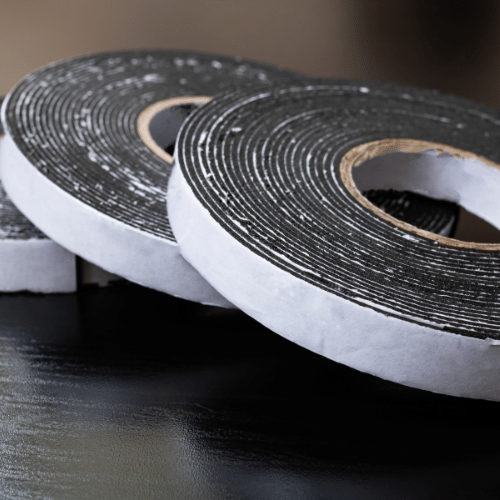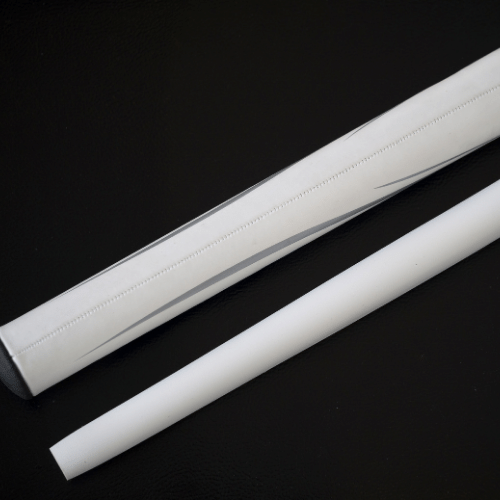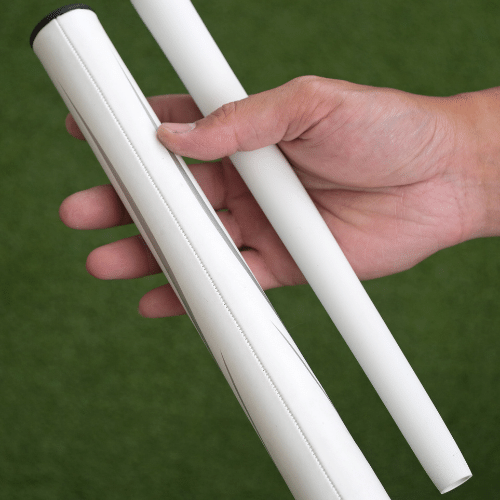Today in this guide we while not only be looking at how to re grip a putter, we will be looking at all our golf clubs and see why it’s crucial to pay attention to your equipment. As they say, a golfer is only as good as their clubs, and that includes the grips.
If you’ve noticed a decline in your shot accuracy, it might not be your technique that’s to blame. Worn-out and ineffective grips can significantly impact your performance. That’s where regripping comes in. By learning this simple process, you can restore your clubs to their former glory and give your game a much-needed boost.
Regripping your clubs is a cost-effective way to improve your play, and the benefits are undeniable. So, let’s dive into the world of selecting the right grips and mastering the regripping process to ensure you’re always at the top of your game.
Key Takeaways For How to Re Grip A Putter
- Equipment Attention:
- To unlock your golfing potential, focus on your equipment, especially the grips on your clubs.
- Learn how to re grip a putter and all your other golf clubs.
- A golfer’s performance is closely tied to the quality of their clubs, and grips including the putter grips is crucial.
- Impact of Worn-Out Grips:
- Decline in shot accuracy may not be solely due to technique; worn-out grips significantly impact performance.
- Regripping is a simple, cost-effective process to restore clubs and enhance gameplay.
- Choosing the Right Grips:
- Grip size, material, and texture are crucial factors for selecting the right grips.
- Experiment with sizes for comfort, and consider material preferences for feel and stability.
- Mastering the Regripping Process:
- Use proper tools, such as a hook blade or knife, grip solvent, double-sided tape, vise grip, and rubber vise clamp.
- Removal, tape application, and grip installation are key steps in successful regripping.
- Benefits of Regripping:
- Regripping improves control and accuracy, potentially reducing scoring average by 2-5 strokes per round.
- Fresh grips create a sense of unity between the golfer and clubs, supporting a lower handicap and a more enjoyable game.
Why Regrip Your Clubs
When you regrip your golf clubs, you can greatly improve your control and accuracy on the course, potentially reducing your scoring average by 2-5 strokes per round. Playing with worn or improperly fitting grips not only compromises your game, but it also disconnects you from your equipment.
By regripping, you can gain better control, leading to more precise shots and overall improved performance. This small step creates a sense of unity between you and your clubs, making each round feel like a cohesive effort.
Don’t underestimate the impact of a fresh grip; it silently supports your quest for a lower handicap and a more enjoyable time on the greens.
Choosing the Right Grips
When selecting grips, it’s crucial to choose the right ones that cater to your individual needs and playing style. Here are some considerations to keep in mind:
- Grip Size Selection: It’s essential to pick a grip size that fits your hands perfectly. If it’s too large, it can restrict your wrist action, while a grip that’s too small can lead to over-gripping and inconsistency.
- Benefits of Different Grip Materials: Different grip materials offer unique advantages. For example, soft rubber grips are great for absorbing shock, providing a comfortable feel. On the other hand, corded grips offer superior control, especially in wet conditions, ensuring a secure grip on the club.
- Personal Comfort and Feel: Ultimately, it’s important to choose grips that feel comfortable in your hands. This will enhance your control over the club and boost your confidence on the course.
When it comes to specific recommendations, Golf Pride Tour Velvet grips are a popular choice for their comfortable feel and excellent durability. Additionally, Lamkin Crossline grips offer a firm grip with a unique pattern that promotes consistent hand placement.
Tools for Successful Regripping
To successfully learn how to re grip a putter and your other golf clubs, you’ll need the right tools. These tools are essential for a smooth regripping process and will help you join a community of dedicated players who are committed to improving their game.
Here are the key tools you’ll need to know how to re grip a putter:
- Hook Blade: This tool is used to remove old grips from your clubs. It’s important to use a reliable hook blade to prevent any damage to the shaft during the removal process, Knifes are also ok but these could cause some shaft damages that is why we recommend the hook blade.
- Grip Solvent: A grip solvent is essential for easing the installation of new grips. It helps reduce slip-ups and ensures a secure and proper application of the new grip it also helps clear any debris from the old tape.
- Double-Sided Tape: This tape is used to secure the new grip onto the club. It’s important for ensuring proper alignment and a secure grip, also never use glue and this makes it harder to re-grip in the future.
- Vise Grip: A vise grip is necessary for holding the club steady during the regripping process. It helps avoid any damage to the club and allows for a precise and controlled grip installation.
- Rubber Vise Clamp: This clamp is used to protect the club’s finish during regripping. It prevents any cosmetic damage that could occur during the process.
Removing Old Grips
To enjoy the benefits of new grips, you must first remove the old ones from your golf clubs carefully. This step allows you to select the right materials for your game’s future, considering the precision and comfort valued by your golf community. Here’s how to get started:
- Cut off the old grips: Use a hook blade to carefully slice through the old grip material without damaging the shaft.
- Peel away the grip tape: Remove any remaining tape and scrape off any residue, and pour mineral spirits onto the club, take into account the pros and cons of different grip materials for your next choice.
- Prepare for new grips: Whether you’re regripping oversized or undersized clubs, make sure the shaft is clean and ready for the installation of new grips.
Applying New Grip Tape

Now that your golf club’s shaft is clean and free of old material, it’s time to apply the new grip tape. This step is crucial because it provides a secure foundation for your fresh grips. The thickness of the grip tape is important as it affects the feel and control you have over your club. So, make sure you choose the right thickness that suits your preferences and playing conditions.
Here’s a simple guide to help you know how to re grip a putter:
Step 1: Use double-sided grip tape to securely attach the grip to the club.
Step 2: Apply a solvent to activate the adhesive on the tape.
Step 3: Consider using alternative materials to customize the feel of your grip.
Step 4: Ensure the grip tape has the correct thickness for your comfort.
Step 5: Wrap the tape evenly and smoothly around the shaft, avoiding any wrinkles.
This is may be the most important part of the tape step. You need to make sure you leave a half inch or so of tape hanging off the butt of the club. Once you wrap the tape around the shaft, twist this excess hanging tape to a point and just poke it down into the shaft. This creates a “cover” to the shaft and prevents any grip solvent from getting in the shaft and breaking down the epoxy over time.
https://drivingrangeheroes.com/how-to-regrip-a-putter/
Installing Fresh Grips
This is where we learn how to re grip a putter or golf clubs, to install your fresh grips on your golf club, follow these steps for a successful installation:
- Apply Solvent Liberally: Make sure to generously apply solvent to the inside of the new grip and over the tape on the shaft. This will help the grip glide smoothly onto the club without any resistance.
- Align with Care: Slide the grip onto the shaft while paying close attention to alignment. It’s crucial to ensure that the grip is perfectly aligned, as this will affect your grip pressure and overall comfort while swinging.
- Set and Dry: Once the grip is in place, take a moment to adjust it for final alignment. After that, set the club aside and allow it to dry. This waiting period is important because it allows the solvent to evaporate, ensuring that the grip is securely attached.
Post-Regripping Best Practices

Once you’ve regripped your golf clubs, it’s important to know the best practices for maintaining the quality and durability of your new grips. As a member of a community that values precision and the joy of a well-played round, there are a few things you can do to ensure your grips last.
First and foremost, make sure to let your grips fully dry before taking them out onto the course. This may require some patience, but it’s worth it in the long run to ensure the longevity of your grips.
Additionally, it’s a good idea to regularly clean your grips with mild soap and water. This will help prevent the build-up of oils and dirt that can degrade the grip material and affect your performance.
When it comes to storage, try to keep your clubs in a moderate temperature environment. Extreme heat or cold can cause wear and tear on your grips, so it’s best to avoid exposing them to these conditions whenever possible.
One of the benefits of regripping is the ability to customize your grips to match your playing style. This personal touch not only enhances your comfort but also boosts your confidence on the green. Don’t be afraid to experiment with different sizes and materials to find what works best for you.
Finally, staying connected with fellow golfers can provide valuable tips and insights on how to keep your grips in top condition. Every stroke counts, and having a solid grip can give you the edge you need on the course.
Now, let’s shift our focus to the crucial step of maintaining those grips. Explore our guide on how to clean golf grips to ensure your grips stay in top-notch condition, offering you the grip and confidence you need on the course.
FAQ For How To Re Grip A Putter
Q: What is the process for regripping a putter grip?
A: The process for regripping a putter grip involves removing the old grip and tape, cleaning the putter shaft, applying new tape and grip, and ensuring it is secure and in the desired position.
Q: How do I ensure that the new putter grip is in the correct position?
A: To ensure the new putter grip is in the correct position, measure and mark the desired location on the shaft, and then slide the grip over the tape, adjusting as necessary until it’s in the right place
Q: What should I do with the excess grip at the end of the shaft?
A: After regripping, cut away the excess grip at the end of the shaft using a sharp blade or knife, and then use a solvent-moistened rag to clean off any residue.
Q: How can regripping my putter improve my putting?
A: Regripping your putter with a new grip can improve your putting by ensuring the club feels comfortable in your hands, allowing for better control and a more confident stroke.
Q: How do I know if the new grip is securely in place?
A: After regripping, give the grip a firm twist and shake to ensure it is securely in place on the shaft. It should feel snug and not twist or move with moderate force.

